How to Grow Corn Successfully - Grow, Save Seed, Plant, Harvest
The secret to growing corn successfully is a result of a getting it right at every stage of the process from selecting the corn seed, preparing your soil to watering and looking after your crop until it is time to harvest. If you mess up one of these stages your harvest will not be as good as it could have been.
So, ready to learn how to grow corn successfully?
For those of you living in the northern hemisphere, during the month of October you should be looking at the ears of corn you are harvesting and putting aside those that look good specimens to save seed from for the next planting season.
How to Grow Corn by Selecting Good Seed
- Have a look at your corn plants and pay particular
attention to where the ears of corn are placed along the stalk. Any
corn ear that you are going to
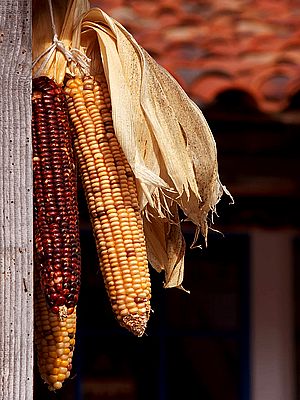 take
for saving seed from must come from those cobs growing
half-way up the stalk.
take
for saving seed from must come from those cobs growing
half-way up the stalk. - Now look at the corn ear and see how it is growing from the stalk, from the shank. You are looking for one that has a shank that is neither too short or too long.
- Choose a corn ear that has a medium, tapering shank that has plenty of leaves covering the kernels.
- Finally, choose corn ears that are at least 8 inches in length. Anything between 8-10 inches is perfect.
- Make sure that the kernels are in even rows, are evenly sized and uniform in color.
- The top of the ear should not be too tapered and should be filled with evenly spaced kernels.
- After the shank is removed it should leave a depression.
- Always harvest more corn ears than you may need just in case they spoil before you will be planting them out in spring.
How to Grow Corn and Storing Saved Seed
In any event, you want to make sure that there is good air circulation that will allow the corn to dry out evenly.
You can achieve this by hanging up the corn, with the husks peeled back (as in the picture above) and suspending them from rafters in a cool, dry place. Or, you can place them on wire racks in single layers under the same conditions.
How to Grow Corn in the Spring
Hopefully you have saved enough ears of corn for the number of acres you want to plant. If I were planting 10 acres of corn, for example, then I would need 150 ears of corn to make sure that we have enough.
But despite having enough seed it must be viable seed and you need to test the seed to see if it is still good.
Testing the Seed and How to Grow Corn Successfully
You will need to number each corn ear at the base of the cob and then take a seed tray, filled with good soil, and divide it into squares, placing numbered tags corresponding to the numbered corn ear.Now take 5 corn seeds from each ear starting from about an inch up from the base and working your way around. Make sure that you don't take seeds from the same row but evenly around the ear working your way up to the top and not taking any seed more than an inch from the top. Place the 5 seeds on top of the soil into the corresponding numbered grids.
Do this for each of your corn ears you will be using for seed and water well. Place a wet Hessian sack over the top and continue to water daily until the corn sprouts.
Never allow the sack or soil to dry out. Once they start to sprout and have grown an inch you will soon be able tell which ears of corn have strong, viable seed and which don't. Now you are ready to plant.
How to Grow Corn and Plant Corn Seed
The best soil for growing corn is one that has had peas grown as a crop the season before. Peas will leave the nitrogen in the soil that the corn will use during its growth. However, you can also grow corn on land that has had wheat growing on it, followed by a clover cover crop that is then disked into the soil.If you are using peas, during the fall, plough up the land or dig in everything left behind from the peas after you have finished harvesting. Dig or plough deep - 8 - 10 inches or even deeper is what you need.
This is one of the best tips I can give you for growing corn successfully - you have to dig the soil deep. By digging deep you are helping to prevent the corn from stressing during any sort of drought or periods of hot weather where you have not watered deeply enough.
Using farmyard manure and compost and adding that to the soil will also add additional nutrients that will help form good ears as the corn plants are growing.
In addition, add 4 oz of fishmeal and 8 oz bonemeal to the square yard, and dig in well.
If you are going to plant in April, you will probably have to plant under cloches. If you wait until May, cloches shouldn't be needed.
Planting Corn Seeds
The type of soil you need is rich humus soil that is loose and warm, with the chance of frost long past. The pH should be between 6.0 and 6.8. Clay loam is the ideal soil for growing corn.If the land was plowed in the fall, it should be double disked and harrowed before you start to plant your corn seeds.
If your soil is moist, sow the seeds to a depth of 1 inch. If your soil is naturally dry, then sow the seeds to a depth of 1 inch and a half.
How to Grow Corn: Planting Corn Seeds in Hills
You can either plant corn in hills, like you would cucumbers with 3 seeds per hill, or you can plant your corn in drilled rows. However, to grow corn successfully the plants should be planted out in several rows together to help with better pollination resulting in a better crop. Planting your corn seeds in hills helps with better drainage as well as creating a warmer soil environment.How Grow Corn: Planting Corn Seeds in Rows
If you are planting in rows then plant in rows 3 feet apart, with seeds spaced 4 inches apart down the rows. Thinning can be done after the plants have grown 4- 6 inches.After your seeds have been planted water well and wait for the plants to emerge.
Once the corn plants are 6-8 inches high, you should cultivate around the plants with a hoe, if you are growing corn on a small scale, or with a cultivator if you are farming corn.
How to Grow Corn as the Pilgrims Did
For those of you who would like to have a slice of living history in your vegetables gardens, then think about growing corn the way the Pilgrim fathers did back in the early 1600s. Today it is known as creating a 3 Sisters Garden.How to Grow Corn : Why it is Important to Cultivate Corn
Corn should be cultivated at least 4 times a year. Why cultivate corn?- Because it helps to keep the weeds down
- Because it helps to create a soil mulch for your corn plants
- Because it helps to aerate the soil and bring nutrients down into the root system
| Countryfarm
Lifestyles Tip: Corn is a plant that needs a lot of phosphorus.
If you see dull, purple streaks down the older leaves, then your plants
have a phosphorus deficiency. Remedy this by giving your plants a good dressing of bonemeal in the fall, as much as 2 lb a square yard, dug well into the soil. If you have well-rotted poultry manure, this will work well as all bird droppings are rich in both nitrogen and phosphorus. |
When to Harvest your Corn
So how do you know when you corn is ready to be picked? The time to harvest your corn is when the kernels are plump and at the milky stage, before they turn starchy. You can easily test the readiness of the corn by opening up one of the ears and picking off a kernel.You will also notice that the tassles that grow beyond the green sheath that covers them has started to turn brown.
Your corn should be ready at about 85 days after planting. However, this is only a rough estimate as the readiness of the corn will depend on the climate, rainfall and variety of corn.
Companion Plants for Corn
Corn and beans are good companion plants. Bush beans, broad beans and climbing beans are all good with corn. However, it isn't just beans that make good companion plants the following do too:If you are going to plant corn with cucumbers, make sure that you plant them on the sunny side of the corn.
Pests and Diseases of Corn
There are several pests that attack corn or maize, so be on the lookout for:
1) European Corn Borer
2) Corn Earworm
3) Fall Armyworm
European Corn Borer:
If you see holes the size of a pin head on the leaves of the corn then it is quite likely that you have European corn borer in your plants. Look for 1 inch cream or light colored worms tinged with pink and brown that also has numerous brown spots.
The worms feed on the stalks as well as the ears of corn.
The moths love the corn silk. Spray with neem oil in June and again in August.
Corn Earworm:
Corn earworms are almost 2 inches in length, they are green or brown in color with light stripes running down the length of their bodies, along the sides and back. Corn earworms are also called tomato fruitworms when they are found on tomatoes.
The larvae eat the tips of the corn ears, after entering through the silk.
These worms are the larvae for the adult moths that lay eggs on the silk and the worms then burrow directly into the tip of the ear. Treat with neem oil when they appear.
Fall Armyworms:
The larvae of the fall armyworm are green to light brown to black with a black stripe on either side of the body. The head has a definite "Y" mark and there are spots on the body. Again, treat with neem oil.
There are also beetles which
will attack corn. Japanese beetles, Flea
beetles and Sap beetles
can all be found on corn plants from time to time.
| Countryfarm Lifestyles Tip: If your corn plants stop growing at about 1 foot high, and the leaves start turning yellow, apply blood and bone around the plants. Blood and bone can be purchased from your garden shops. |
Diseases of Corn and Maize
Not only do you have to watch out for the beetles, worms and moths, but corn can also be attacked by disease. Especially:-1) Smut
2) Stewart's Bacterial Wilt
3) Rust
4) Leaf Spot
1) Smut
Smut can be seen as either white or black powdery spores on the leaves, stems, ears and tassles of the corn. It usually happens when the plants have been damaged by poor cultivation, hail damage or insects.2) Stewart's Bacterial Wilt
Stewart's bacterial wilt is seen as yellowish or brown streaks on the leaves and stalks of the corn, especially at the soil line can be affected. Sometimes damage is so severe that plants can end up rotting and dying. Other times plants can become stunted. This is a bacterial disease that is carried by flea beetles.3) Rust
Rust can be seen as red, brownish powdery patches on the surface of the leaves.4) Leaf Spot
Leaf spot is a disease that often appears at the end of the season. Elongated spots from white to light tan, to reddish brown with a red border can be found on the leaves.Corn Varieties for both Yellow and White Corn
Well-known open pollinated yellow varieties are Golden Bantam and Golden Sunshine.Open pollinated white sorts, in the order of maturity, are Early Evergreen, Country Gentleman, and Stowell Evergreen.
| Countryfarm Lifestyles Tip: Yellow corn is more nutritious than white corn. It is also better for canning than the white variety. |
Other Resources that you
May be Interested In
Go from How to Grow Corn back to
Growing VegetablesGo to Organic Gardening
Don't miss out on our latest news and articles. Sign up for our free monthly e-zine!
Go to from How to Grow Corn, back to Grow VegetablesGo to Self Sufficient Living
Go to Countryfarm Lifestyles and Homesteading





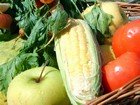

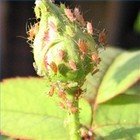
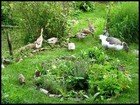
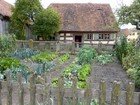

New! Comments
Do you have something of value to add? Leave me a comment in the box below.